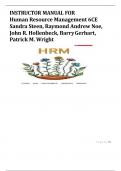INSTRUCTOR MANUAL FOR
Human Resource Management 6CE
Sandra Steen, Raymond Andrew Noe,
John R. Hollenbeck, Barry Gerhart,
Patrick M. Wright
P a g e 1 | 161
,Table of Contents
SECTION 1: The Human Resource Environment
Chapter 1: Strategies, Trends, and Challenges in Human Resource Management
Chapter 2: Equity, Fairness, Health, and Safety in the Workplace
SECTION 2: Preparing for and Acquiring Human Resources
Chapter 3: Analyzing Work and Designing Jobs
Chapter 4: Planning for and Recruiting Human Resources
Chapter 5: Selecting Employees
SECTION 3: Talent Management
Chapter 6: Training, Learning, and Development
Chapter 7: Managing Employees' Performance
SECTION 4: Compensating and Rewarding Human Resources
Chapter 8: Total Rewards
SECTION 5: Meeting Other HR Goals
Chapter 9: Labour Relations
Chapter 10: Managing Human Resources Globally
Chapter 11: Creating and Sustaining High-Performance Organizations
P a g e 2 | 161
,Chapter 1-11
Chapter 1: Strategies, Trends, and Opportunities for HRM
Lecture Outline
Prepared by: Nicole Vincic, Mohawk College
LEARNING OBJECTIVES
LO1: Define human resource management and explain how HRM contributes to organizational
performance.
LO2: Describe how human resource management supports and shapes organizational strategy.
LO3: Summarize competencies, careers, and ethics in human resource management.
LO4: Describe trends in the labour force composition and how they affect human resource
management.
LO5: Discuss how technological developments are impacting human resource management.
INTRODUCTION: Human Resources Take Centre Stage
• According to David Windley, President of IQTalent Partners, a segment of Canada’s Caldwell
Partners, this is an unsurpassed time to be working in human resources management.
• Technology is changing the way work gets done by automating many tasks carried out by
humans.
• Organizations need people for their creativity and judgement.
• HR placed in a key role of providing talent, keeping talent, and bring out the best in talent.
HRM PRACTICES
Human resource management (HRM) centres on the policies, practices, and systems that influence
employees’ behaviour, attitudes, and performance.
Reference Figure 1.1
Important HR (people) practices include:
• Analysis and design of work
• Workforce planning (determining how many employees with specific knowledge and skills are
needed)
• Recruiting (attracting candidates) and Selection (choosing employees)
• Training, learning, and development (preparing employees how to perform their jobs and for the
future)
P a g e 3 | 161
, • Performance management (supporting performance)
• Total rewards (rewarding employees)
• Employee and labour relations (creating a positive work environment)
WHY ARE PEOPLE SO VALUABLE?
Managers and economists traditionally have seen HRM as a necessary expense, rather than a source of
value to their organizations
• Human capital—an organization’s employees, described in terms of their training, experience,
judgment, intelligence, relationships, and insight
• Organizations need resources that provide competitive advantage and human resources have
these qualities: Valuable, rare, cannot be imitated, and have no good substitutes
• Employee engagement refers to the degree to which employees are fully involved in their work
and the strength of their commitment to their job and the organization.
IMPACT OF HRM
HRM contributes to measures of an organization’s success such as quality, profitability, and customer
experience. Reference Figure 1.2
Organizations need the kind of resources that will give them such an advantage. Human resources have
these necessary qualities:
• Human resources are valuable.
• Human resources are rare in the sense that a person with high levels of the needed skills and
knowledge is not common.
• Human resources cannot be imitated.
• Human resources have no good substitutes.
THE IMPACT OF EMPLOYEE EXPERIENCE
• Perceptions that employees have about their experiences at work in response to their
interactions with the organization
• Providing a positive employee experience is critical for keeping employees engaged and
committed to the organization
• Encompasses all the elements that influence an employee’s perception of the work environment
and becomes an important focus for the employee’s entire journey—from first contact with a
potential employer to retirement (and even beyond)
WHAT ARE THE RESPONSIBILITIES OF HR DEPARTMENTS?
HR as a business within the organization with 3 product lines:
1. Strategic partner
• Contributing to the company’s strategy
• HR professionals must understand the business, industry, and competencies
P a g e 4 | 161




